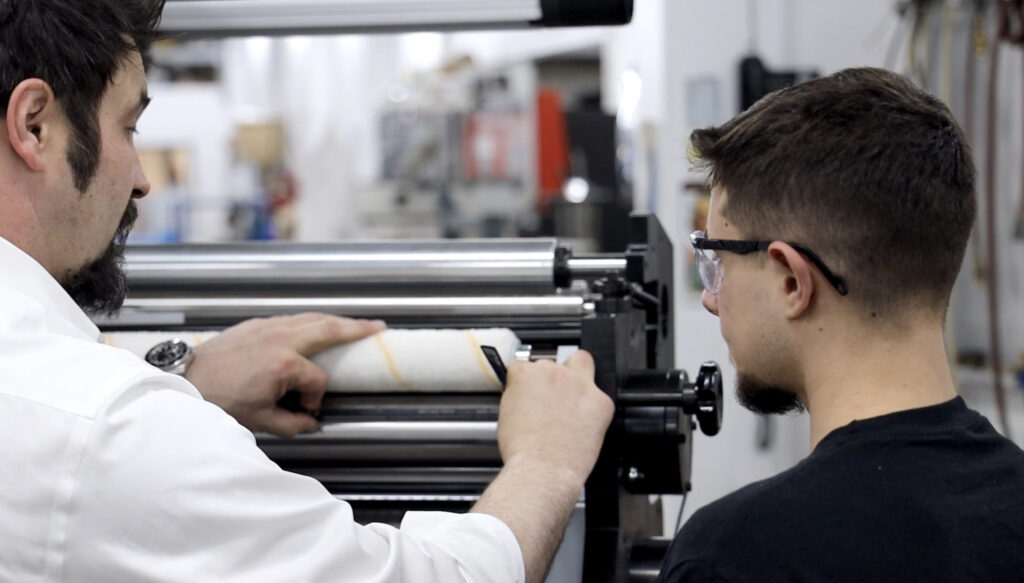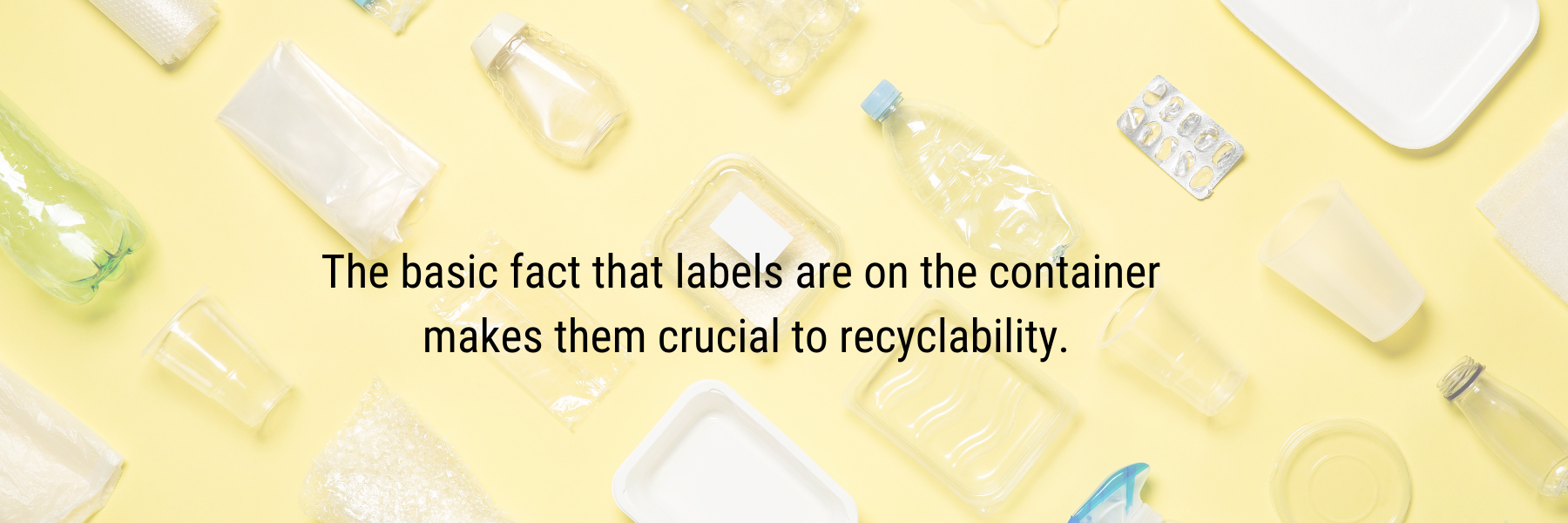This article was originally published on 5/23/2022 and updated on 12/27/2024
The Role of Labels in Recycling
Recyclability has become a cornerstone of modern packaging, with brands and manufacturers under increasing pressure to meet sustainability goals. Labels, though small, play an outsized role in determining whether packaging can be effectively recycled. They are integral to recycling, impacting everything from material compatibility to sorting efficiency.
Both brands and Print Service Providers (PSPs) must carefully evaluate label materials, design, and adhesives to support recycling outcomes. By aligning these elements with established recycling protocols, they can minimize waste, enhance the recyclability of packaging, and appeal to eco-conscious consumers.
The Importance of Recycling in Packaging
Consumer demand for sustainable products is transforming the packaging industry. Today’s shoppers actively seek brands that prioritize eco-friendly practices, and recycling has become a key sustainability metric. As a result, packaging design must evolve to meet these expectations.
For PSPs, recycling is not just a trend—it’s a necessity. Adopting recycling-friendly materials and processes is critical for maintaining relevance in a market that values environmental responsibility. Moreover, PSPs who fail to align with recycling protocols risk producing packaging contaminating the recycling stream, potentially harming their clients’ reputations and undermining global sustainability efforts.
Recycling isn’t just here to stay—it’s shaping the future of packaging design. By prioritizing recyclability, PSPs and brands can drive positive environmental impact while meeting consumer expectations.
Label Characteristics that Affect Recyclability
The characteristics of labels heavily influence the recyclability of packaging. From material compatibility to adhesive selection, labels must be designed to integrate seamlessly into recycling processes. By adhering to best practices, brands, and PSPs can help ensure their packaging supports rather than hinders recycling efforts.
Material Compatibility
Labels must be compatible with the recycling process for the specific container material they are affixed to. For instance, paper labels on plastic containers can contaminate wash water during recycling. As the paper dissolves into pulp, it leaves fibers that are difficult to filter out, ultimately reducing the quality of the recycled plastic.
The Association of Plastic Recyclers (APR) has developed guidelines to help brands choose label materials supporting recycling. By selecting compatible materials, such as APR-approved films for PET containers, brands can enhance the recyclability of their packaging.
Label Size and Coverage
Large labels can obstruct sorting equipment from identifying the underlying container material, making it difficult for recyclers to process the container correctly. The APR recommends specific label coverage guidelines for PET containers to improve sortation accuracy:
- Containers up to 550 ml: Label coverage should be less than 55%.
- Containers over 550 ml: Label coverage should not exceed 70%.
These guidelines ensure that sorting equipment can identify the container material accurately, improving recycling efficiency.
Metallization
Even thin layers of metallization on labels can pose significant challenges for recycling. Recycling equipment is designed to detect and reject materials containing metal, which can lead to otherwise recyclable containers being discarded. Avoiding metalized labels on plastic containers improves their chances of being successfully processed through the recycling stream.
Adhesives
The adhesives used to affix labels can disrupt recycling processes if they are difficult to remove or incompatible with the container material. Adhesives that remain intact during recycling can prevent labels from separating properly, leading to contamination. Choosing adhesives that are easily washed off or compatible with the recycling process ensures smoother operations and higher-quality recycled materials.
Strategies for Improving Label Recyclability
PSPs and brands must adopt strategies that enhance label recyclability to support sustainable packaging efforts. By making thoughtful choices in materials, design, and adhesives, they can ensure their packaging is better suited for recycling systems.
Choose APR-Recognized Label Materials
Selecting materials that meet APR guidelines is one of the most effective ways to improve label recyclability. These materials are designed to align with recycling protocols for container materials like PET and HDPE. Using APR-recognized materials helps reduce contamination and supports producing high-quality recycled products.
Optimize Label Design
The design of a label plays a critical role in its recyclability. Reducing label coverage allows sorting equipment to identify the underlying container material better. Avoiding full-wrap labels or designs that obscure container surfaces ensures packaging can be processed efficiently. Incorporating these design principles enhances recyclability and aligns with sustainability goals.
Select Sustainable Adhesives
Sustainable adhesives that wash off easily or do not contaminate recycling streams are essential for successful recycling. Testing adhesives for compatibility with recycling systems is an important step in the design process. Adhesives specifically formulated for recycling environments prevent issues like label residue, which can disrupt material processing.
Educate PSPs and Brands
Educating PSPs and brands about best practices for label recyclability is key to driving industry-wide change. PSPs should adopt sustainable practices in their manufacturing processes and collaborate with brands to design packaging that meets recyclability standards. They can create packaging solutions that align with environmental goals and meet consumer demand for sustainable products by working together.
Innovations in Sustainable Labeling
Advancements in labeling materials and technologies are creating new opportunities for sustainable packaging. From antimicrobial labels to biobased and recycled materials, these innovations improve recyclability and meet the growing consumer demand for eco-friendly products.
- Antimicrobial Labels: Developed during the pandemic, these labels address consumer concerns about hygiene while maintaining compatibility with recycling protocols.
- Biobased Materials: Substrates like hemp-based labels and post-consumer recycled content are gaining traction as sustainable alternatives. These materials reduce reliance on virgin resources while enhancing recyclability.
- Improved Recycling Technologies: Advances in adhesive formulations, material science, and recycling infrastructure are helping to close the loop on label recyclability, making it easier for packaging to re-enter the supply chain.
Advanced Web Finishing Equipment Supports Sustainable Labeling
Tamarack Products has been at the forefront of providing advanced labeling solutions that align with sustainability goals. With over 50 years of experience, Tamarack offers equipment designed to enhance the production of recyclable packaging while maintaining efficiency and precision.
Tamarack’s P500 Integral Labeling Equipment
The P500 Integral Labeling Equipment is an inline system that applies labels with exceptional accuracy and speed. Its ability to handle a variety of materials, including sustainable substrates, makes it an ideal choice for brands committed to eco-friendly practices.
Key Features:
- Precise label application with ±1/32” accuracy.
- High-speed operation up to 500 feet per minute for large production runs.
- Flexibility to handle sustainable materials and various label designs.
Tamarack’s P500 offers the ability to include RFID tag manufacturing.
Tamarack’s Versa Web SE Offline Labeling Equipment
For projects requiring more flexibility, the Versa Web SE Offline Labeling Equipment offers robust performance. This equipment is ideal for short runs, custom projects, and specialty labeling needs.
Benefits of Tamarack Equipment:
- Minimized waste through precise application.
- Compatibility with a wide range of materials, including biobased and recycled options.
- Support for brands aiming to meet APR standards and recyclability goals.
By partnering with Tamarack, brands, and PSPs can produce high-quality labels that support sustainable packaging initiatives.
Labels play a critical role in determining the recyclability of packaging. Brand and PSPs can significantly improve recycling outcomes by addressing key factors such as material compatibility, size, coverage, metallization, and adhesive selection. Implementing strategies like adopting APR-recognized materials, optimizing label design, and selecting sustainable adhesives ensures that packaging aligns with environmental goals and consumer expectations.
Partner with Tamarack for Efficient, Sustainable Integrated Labeling Solutions
Tamarack’s advanced labeling and web finishing equipment, such as the P500 Integrated Labeling System and Versa Web SE Offline Labeling Equipment, supports the production of recyclable labels with precision and efficiency. These innovations help businesses create packaging that meets regulatory standards and contributes to a more sustainable future.
Tamarack Products offers cutting-edge labeling equipment designed to improve recyclability and support sustainable packaging initiatives. With decades of expertise, we provide tailored solutions to help businesses achieve precision, efficiency, and environmental responsibility. Contact us today to learn how our advanced systems can help you meet your sustainability goals.





